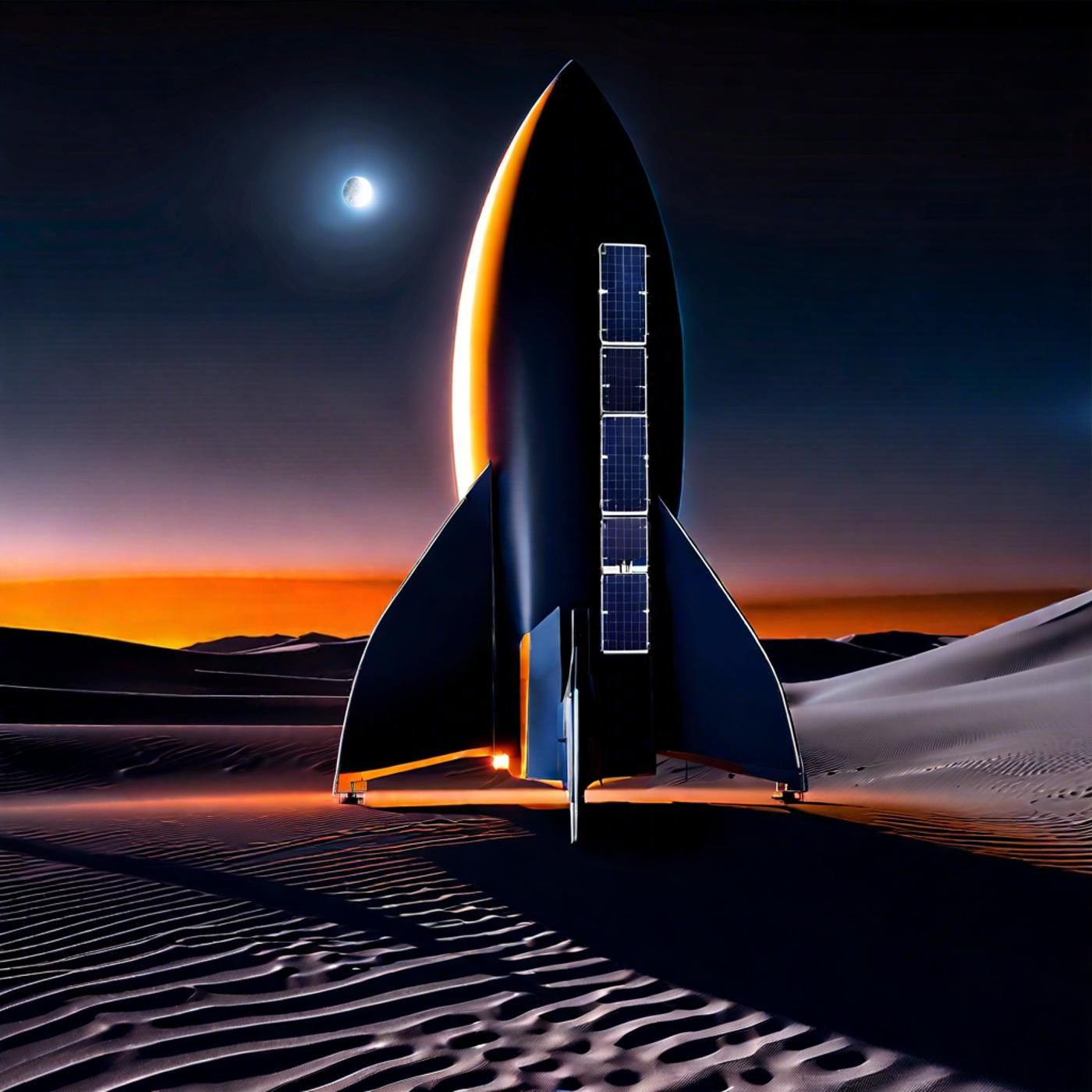S03E92: Mars Habitat Crew's Return & Starlink's Direct-to-Cell Leap
Welcome to Astronomy Daily, your go-to podcast for the latest news and updates from the fascinating world of astronomy and space exploration. I'm your host, Anna, and I'm thrilled to have you with us today.
We've got a lineup of exciting stories that...
Welcome to Astronomy Daily, your go-to podcast for the latest news and updates from the fascinating world of astronomy and space exploration. I'm your host, Anna, and I'm thrilled to have you with us today.
We've got a lineup of exciting stories that span from groundbreaking missions to the cutting-edge technology shaping our future in space.
In today's episode, we're diving into the extraordinary journey of NASA's Mars habitat crew, who are about to step out after more than a year in simulated Martian conditions. We'll also take a look at SpaceX's latest Starlink launch, which has introduced new direct-to-cell satellites aimed at revolutionizing connectivity. Additionally, we'll explore NASA's call for feedback on new commercial space station requirements and wrap up by discussing the ambitious Polaris Dawn mission set to achieve the first-ever private spacewalk.
So sit back, relax, and let's embark on this cosmic adventure together.
Don't forget to visit our website at astronomydaily.io, where you can stay up to date with the latest space news through our continually updating news feed. There, you'll also find additional resources and the full archive of our podcast episodes available for streaming anytime. Stay curious, keep looking to the stars, and make sure to tune in next time for more cosmic insights and adventures. Until then, this is Anna signing off. Clear skies and happy stargazing.
https://www.astronomydaily.io
https://www.bitesz.com
Become a supporter of this podcast: https://www.spreaker.com/podcast/astronomy-daily-the-podcast--5648921/support.
This podcast features the latest news and updates from astronomy and space exploration
Anna: Welcome to Astronomy Daily, your go to Podcast for the latest news and updates from the fascinating world of Astronomy and space exploration. I'm your host Anna, and I'm thrilled to have you with us today. We've got a lineup of exciting stories that span from groundbreaking missions to the cutting edge technology shaping our future in space. In today's episode, we're diving into the extraordinary journey of NASA's Mars habitat crew, who are about to step out after more than a year in simulated martian conditions. Well also take a look at SpaceXs latest Starlink launch, which has introduced new direct to cell satellites aimed at revolutionizing connectivity. Additionally, well explore NASAS call for feedback on new commercial space station requirements and wrap up by discussing the ambitious Polaris dawn mission set to achieve the first ever private spacewalk. So sit back, relax, and lets embark on this cosmic adventure together.
First volunteer crew inside NASA's Mars habitat simulator celebrates one year milestone
Imagine spending over a year in isolation, simulating life on Mars to help humanity prepare for its next giant leap. That's exactly what the first volunteer crew inside NASA's Mars habitat simulator at the Johnson Space center in Houston has just accomplished. This Saturday, Kelly Hasten, Anka Soleriu, Ross Brockwell, and Nathan Jones will be stepping out of Chapia's 3d printed Mars Dune Alpha habitat after an astonishing 378 Daily. For more than a year, the crew members have lived and worked in this isolated 1700 square foot habitat designed to mimic the conditions of Mars as closely as possible. The simulation aimed to test and prepare for future Mars missions by creating an environment where the crew face similar challenges to those they might encounter on the red planet. This includes everything from virtual reality Mars walks to growing and harvesting vegetables to supplement their shelf food. The crew entered Chepia back on June 25, 2023, embarking on a mission that involved not just maintaining equipment, but also managing stressors like isolation and communication delays with Earth. They followed a Daily routine, conducting Mars mission operations that gave invaluable insights into how humans might live and work on Mars. As NASA commemorated their one year milestone last week, the impact of their mission was underscored. NASA stated the chapel mission one crew has celebrated one year in a simulated Mars habitat at NASA Johnson. Research done during missions like Chapea helps us prepare for future Artemis missions by learning how to live and work safely in deep space conditions. The journey to this point began back in September 2021, when NASA started seeking participants for a one year Mars surface mission simulation. The application process was rigorous, including a strong warning about the risks, which ranged from loss of privacy to even potential physical injury or death, albeit highly unlikely. After 18 months of interviews and selections, the volunteers were ready to take on this remarkable challenge. But why go through all this trouble? Well, the data gathered from Chepia will play a critical role in NASA's Artemis campaign, which aims to return astronauts to the moon and eventually send crewed missions to Mars for the first 1st time. The challenges faced and solutions found during Chapia are instrumental in ensuring that when humanity does set foot on Mars, well be prepared for the rigors that lie ahead. In addition to the year long simulation, NASA is also performing shorter 45 day simulated journeys using the human Exploration Research analog facility. These shorter missions help refine the strategies and equipment necessary for deep space exploration, and additional volunteer groups continue to cycle through these simulations. The Chapia crew will be greeted with a short welcome ceremony upon their exit, which can be viewed on multiple platforms, including NASA television and NASA plus. This milestone brings valuable insights into the logistics, physical demands and psychological aspects of long term space missions, bringing us one step closer to making human life on Mars a reality.
SpaceX's Falcon nine rocket successfully launched 20 new Starlink satellites
SpaceX has once again made headlines with its recent Starlink launch, marking the company's first mission for the month of July. The launch, though delayed by 2 hours due to technical issues, successfully took off at 04:55 a.m. EDT from Cape Canaveral Space Force Station in Florida. This mission, designated Starlink eight nine, is part of SpaceX's ambitious project to create a mega constellation of satellites aiming to provide high speed, low latency Internet across the globe. Aboard the Falcon nine rocket were 20 new Starlink satellites, 13 of which are equipped with direct to cell capability. This cutting edge technology promises to deliver ubiquitous connectivity directly to users phones, essentially transforming how we think about staying connected. With this launch, the total number of direct to cell satellites now in orbit has reached 103, demonstrating SpaceX's commitment to revolutionizing mobile connectivity. The launch window for this mission opened at 02:57 a.m. EDT, but a last minute technical hiccup delayed liftoff. Despite this minor glitch, the Falcon nine rocket lifted off smoothly, making its way to space and successfully deploying its payload of 20 satellites into low Earth orbit. Just eight minutes after liftoff, the rocket's first stage booster completed its descent, landing safely on the drone ship, a shortfall of gravitas stationed in the Atlantic Ocean. This successful mission marks SpaceX's 49th dedicated Starlink launch this year and continues to bolster the Starlink constellation, which now stands as a formidable presence in the skies. The company has announced plans to maintain an average launch rate of twelve Falcon rockets per month, with an ambitious goal of completing 144 launches by the end of the year, according to company officials. They remain on track to meet these lofty targets. Following the launch, SpaceX celebrated another milestone. Starlink's high speed, low latency Internet service is now available in Madagascar, further expanding its global reach. This follows a series of successful launches in June and earlier months, each contributing dozens of new satellites to the constellation. The overarching goal of SpaceX's Starlink project is to provide Internet service to remote and underserved areas of the planet, thereby bridging the digital divide. The addition of direct to cell satellites takes this mission a step further, offering the potential for seamless phone connectivity even in areas where traditional cell towers are absent or unreliable. With each launch, SpaceX gets closer to achieving its vision of a globally connected world. The company's ability to adapt and overcome technical challenges, as demonstrated by this latest mission, speaks volumes about its ingenuity and perseverance. As the year progresses, we'll be keeping a close eye on SpaceX and its Starlink launches, eager to see how the company's ambitious plans continue to unfold, stay tuned, as there are sure to be more exciting updates and developments in the realm of space based Internet connectivity.
NASA seeks feedback from companies on requirements for new commercial space stations
SpaceX is not just launching satellites, it's launching us into a new era of global communication. M NASA is stepping up its efforts to pave the way for the future of space exploration by seeking feedback from american companies on the requirements for new commercial space stations. This move is a significant part of NASA's strategy to transition its low Earth orbit operations from government controlled frameworks to commercially owned and operated space destinations. The goal? To ensure that we continue our access to and presence in space for vital research, technology development, and international collaboration even after the International Space Station, or ISS, retires. Through a request for information, or RFI, NASA is calling on industry leaders to provide their input on the agency's anticipated requirements for these new commercial destinations. These standards will guide companies in designing systems that meet NASA's stringent human rating requirements for low Earth orbit operations and safe transportation. An industry briefing day is scheduled for October 12, with responses due by November 17, making this a critical timeframe for businesses to weigh in. Phil McAllister, director of commercial spaceflight at NASA headquarters, emphasized the importance of this step, stating, this RFI is a significant next step in transitioning low earth orbit operations to the private sector, allowing NASA to be one of many customers for services. The collaborative effort aims to outline requirements that are not only safe and reliable, but also cost effectiveness, enhancing the viability of commercial space stations NASA's vision includes supporting the development of multiple new stations through a combination of funded and unfunded agreements. It's crucial to note that companies do not need to have a pre existing relationship with NASA to contribute feedback or bid on future contracts. Angela Hart, manager of the Commercial Low Earth orbit development program at NASA's Johnson Space center, highlighted the innovative spirit within the industry, saying, we are working in lockstep with multiple companies to help guide them in a way that sets them up for success. To meet our requirements. The agency has previously sought industry input in 2022 and early 2023 and has hosted industry Daily to discuss assumptions and expectations for technical and business plans. This ongoing dialogue with the commercial sector is essential as it helps NASA refine and improve its commercial services strategy for low Earth orbit destinations. The overarching goal is ambitious yet clear to foster a robust commercial marketplace in low Earth orbit, where NASA is merely one of many customers. This approach is designed not only to reduce costs for governmental space missions, but also to spur innovation within the private sector. By doing so, NASA can focus its resources and efforts on its Artemis missions to the moon and eventually crewed missions to Mars, while continuing to utilize low Earth orbit as a critical training and proving ground for these deeper space missions. For more detailed information and to participate in the RFI, interested parties can visit Sam Dot gov Dot.
Polaris dawn aims to launch first private spacewalk on July 31
This initiative serves as a foundational step in ensuring the continued advancement and sustainability of space exploration, marking an exciting transition into a new era of commercial space operations let's dive into the fascinating world of Polaris dawn, an ambitious project funded by billionaire Jared Isaac Mann, Polaris dawn is poised to make history by launching the first ever private spacewalk, marking a new chapter in commercial space exploration. This remarkable mission is part of the Polaris program, which intends to push the boundaries of human spaceflight and set new precedents for private sector involvement in space exploration. Slated for launch no earlier than July 31, Polaris dawn will lift off from Earth aboard a SpaceX dragon capsule propelled by a falcon nine rocket. This mission is no small feat. Its planned orbit will take the crew about 435 miles above Earth, making it the highest altitude crewed flight since the notable Apollo moon missions of the 1960s and 1970s. By comparison, the International Space Station orbits at roughly 250 miles above Earth, highlighting the daring ambition of this mission. The Polaris dawn team is composed of experienced and dedicated individuals, each bringing their unique expertise to the mission. Leading the crew is Jared Isaac Mann, himself a, uh, seasoned pilot and CEO of shift four payments, who already has cosmic credentials from his all civilian inspiration. Four mission back in 2021. Serving as the pilot is retired United States Air Force Lieutenant Colonel Scott Kidd Poteet, with mission specialists Sarah Gillis and Anna Menon, both accomplished SpaceX operations, engineers rounding out the team. One of the key highlights of Polaris dawn is its groundbreaking spacewalk. This feat will be executed using bespoke SpaceX spacesuits designed specifically for the mission's unique challenges. The spacewalk isn't just for show it serves as a technological proving ground, ensuring systems and suits can handle the demands of future space missions. Alongside the spacewalk, the crew will conduct a series of scientific and technical experiments designed to expand our understanding of space travel and its impacts on the human body. The Polaris dawn mission is the first of three planned missions under the Polaris program, all funded and commanded by Isaac Mann. This program builds upon the success of Inspiration Four, which not only highlighted the capabilities of private spaceflight but also raised a remarkable $250 million for St. Jude Children's Research Hospital. Isaac Mann plans to continue his philanthropic endeavors with the Polaris missions, intertwining space exploration with meaningful causes training for the Polaris dawn mission has been intensive and meticulous. The crew has undergone rigorous preparation to ensure they are ready for the mission's demands. Poteet mentioned in a discussion on May 4 that their training has incorporated stressful environments and situations, aiming to bolster team cohesion and identify areas where support may be needed. This training is pivotal, as it not only prepares the crew for the challenges of space, but also enhances their ability to adapt to unforeseen circumstances. The road to launch has not been without its hiccups. Initially aimed for late 2022, the mission faced several delays, with the most recent in February 2024, pushing the target launch from April into the summer. Nonetheless, these delays have allowed crucial development time, ensuring that all mission goals can be safely and effectively meth. In summary, Polaris dawn stands at the frontier of commercial space exploration, combining groundbreaking technological advancements with scientific research. As the first mission of the Polaris program, it sets a precedent for future private space endeavors, underscoring the potential for commercial sector contributions to our understanding and exploration of space. Jared Isaac Mann and his crew are not just reaching for the stars, but also paving the way for the next generation of explorers. Stay tuned as we follow their journey into the cosmos.
This is the end of today's episode of Astronomy Daily
And that brings us to the end of today's episode of Astronomy Daily. Thank you for joining us as we explored the groundbreaking achievements and exciting updates from the world of space exploration. We hope you enjoyed learning about NASA's Mars habitat simulator. SpaceX's latest starlink launch, NASA's plans for new commercial space stations, and the upcoming Polaris dawn mission. Don't forget to visit our website at astronomydaily IO, where you can stay up to date with the latest space news through our continually updating news feed. There. You'll also find additional resources and the full archive of our Podcast episodes available for streaming anytime. Stay curious, keep looking to the stars, and make sure to tune in next time for more cosmic insights and adventures. Until then, this is Anna signing off. Clear skies and happy star gazing.
New to Astronomy Daily - The Podcast?
Here are some great episodes to start with.



















